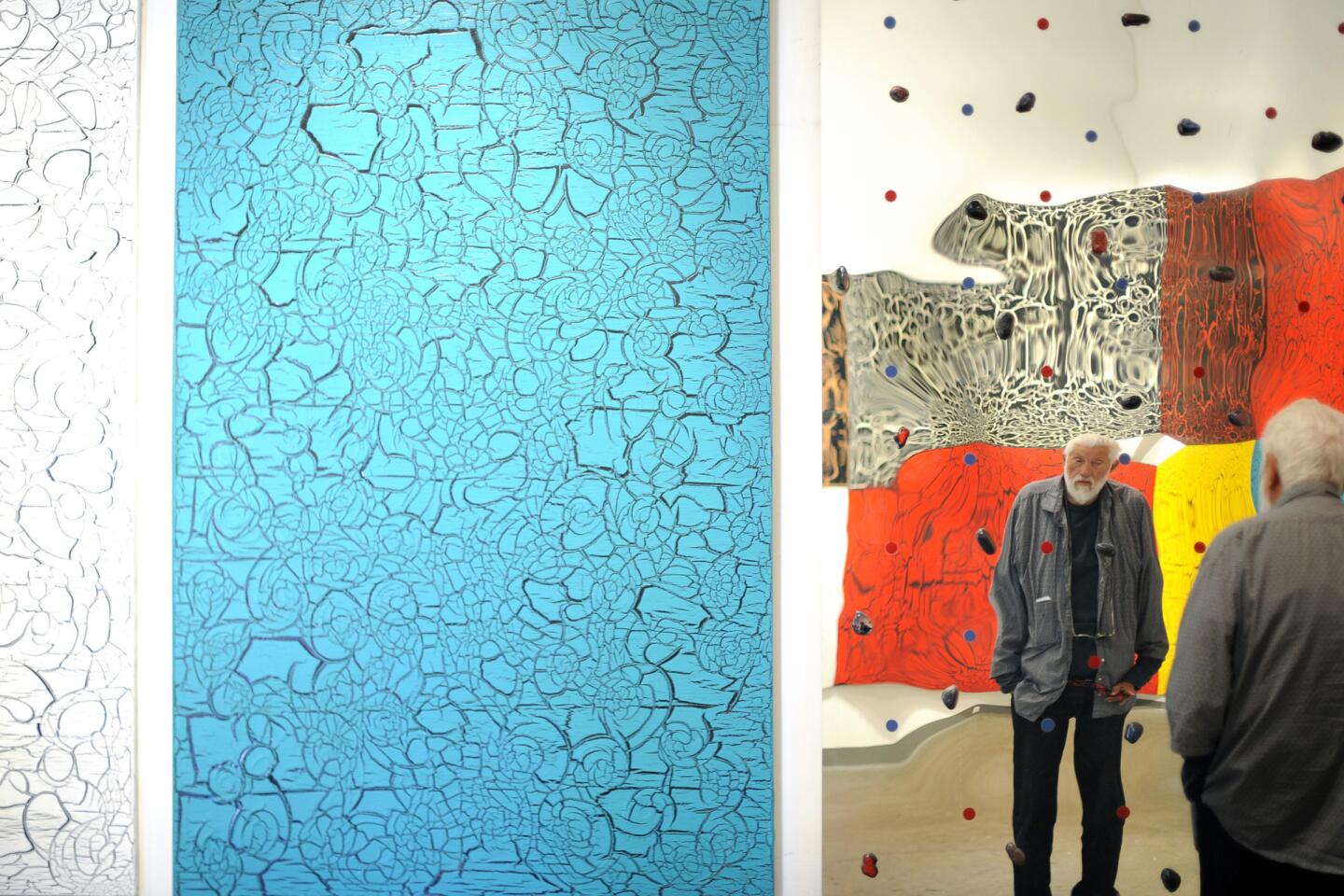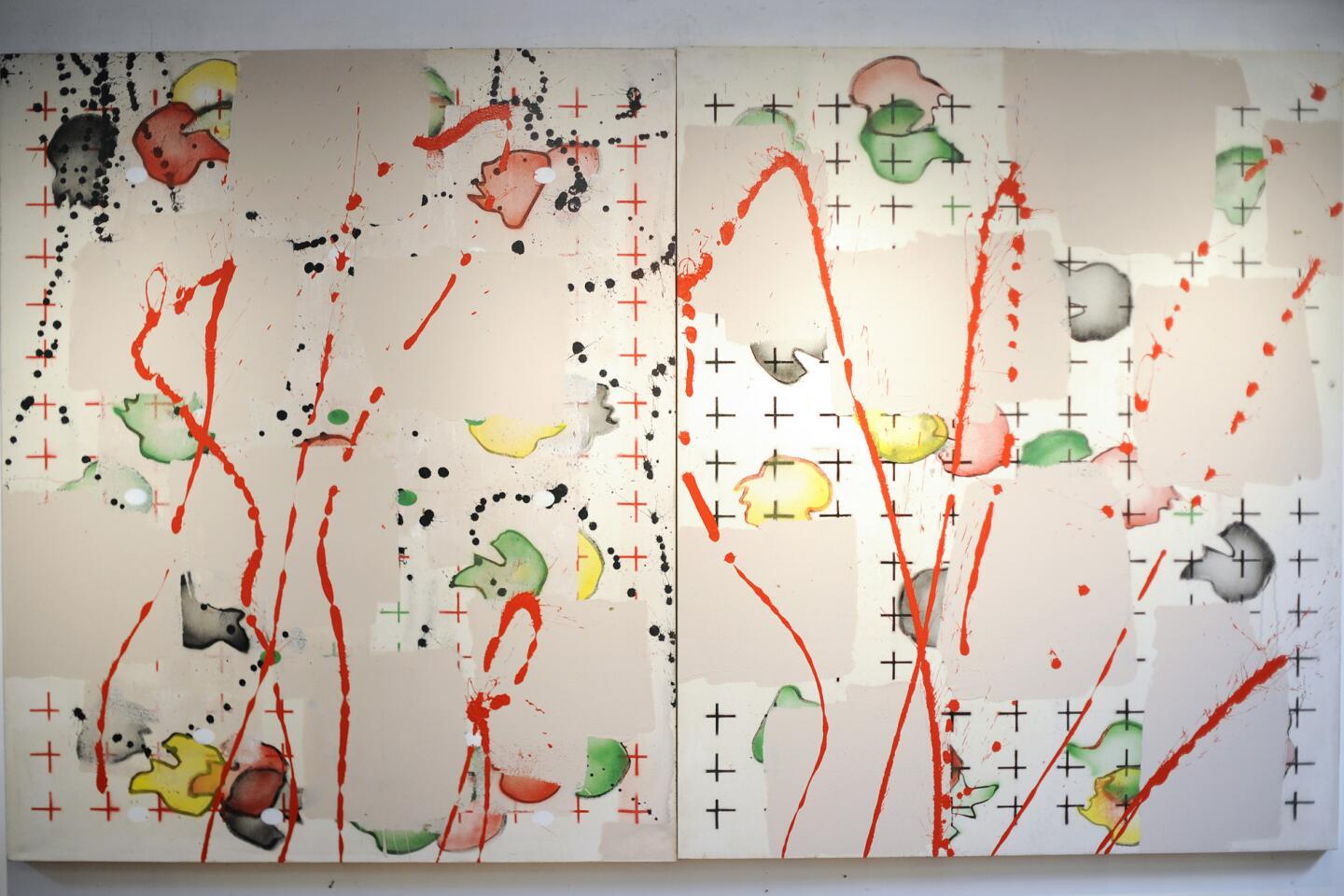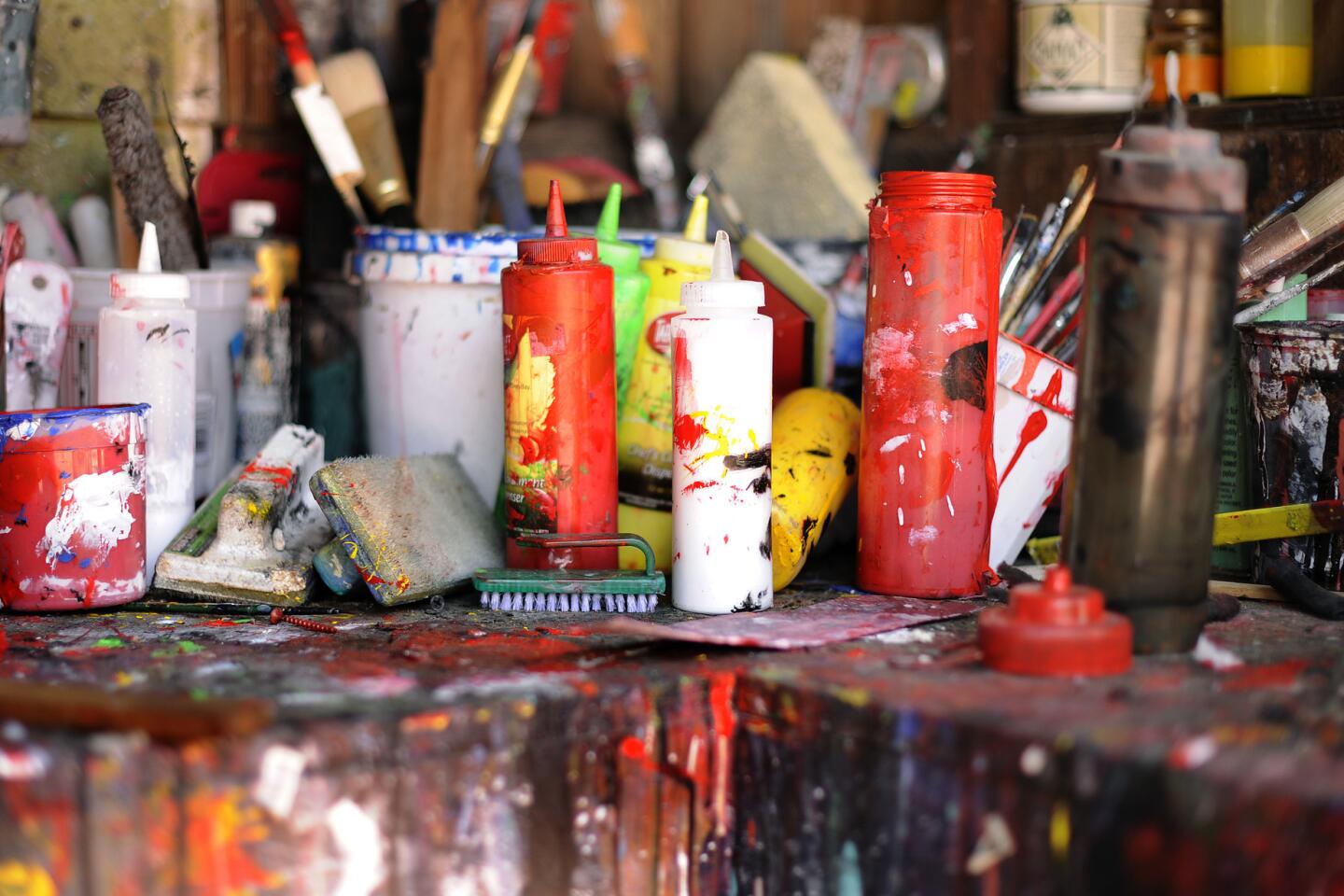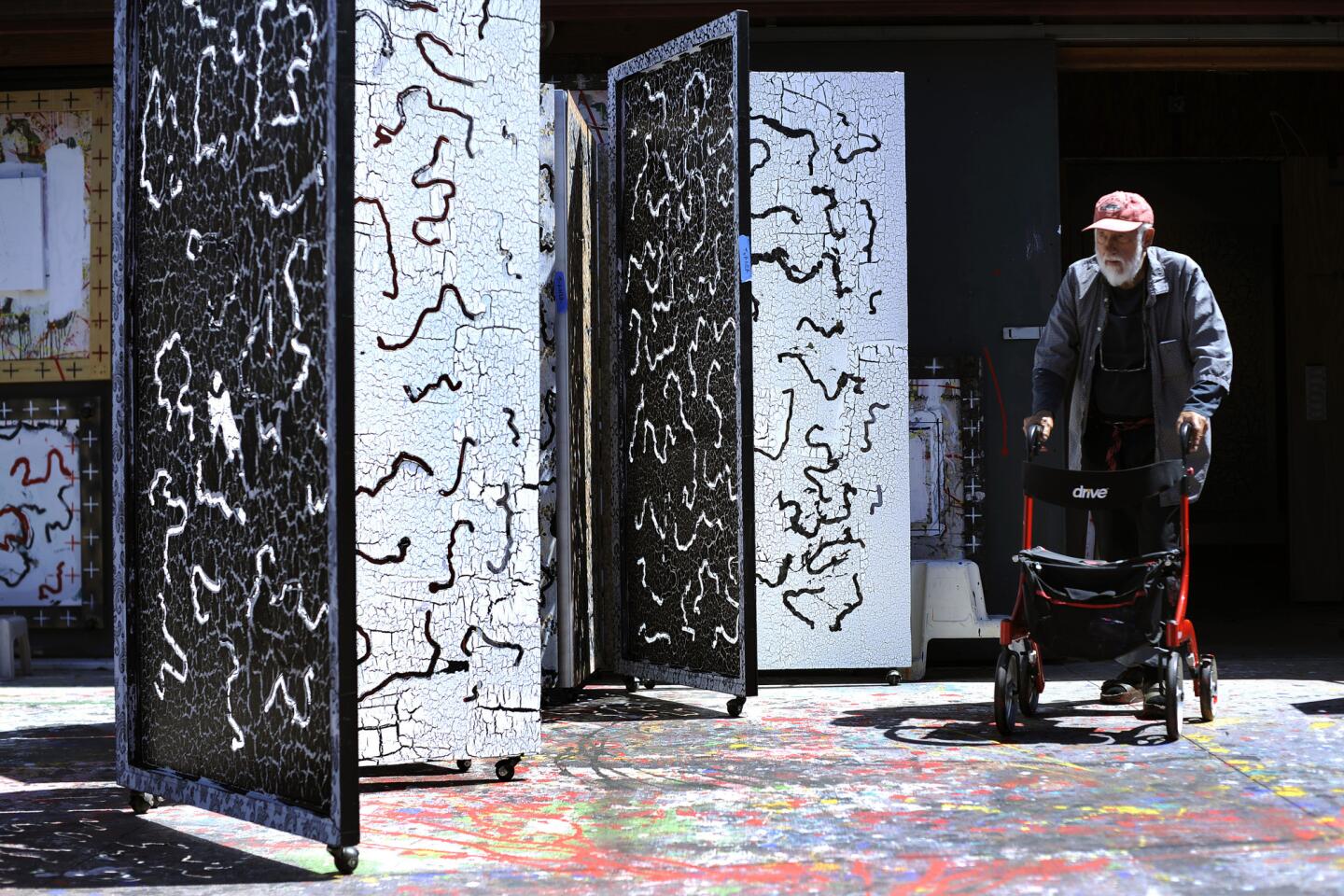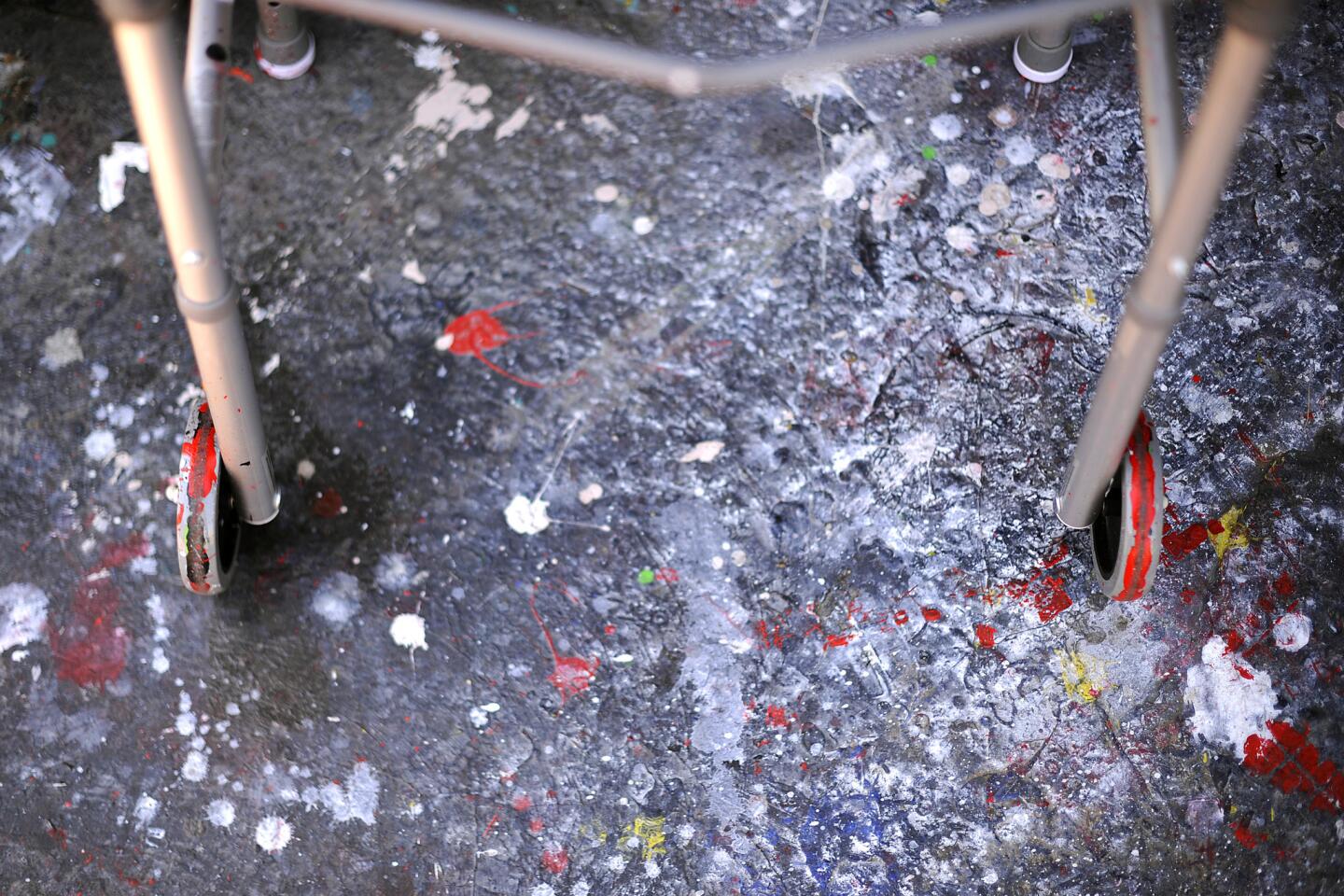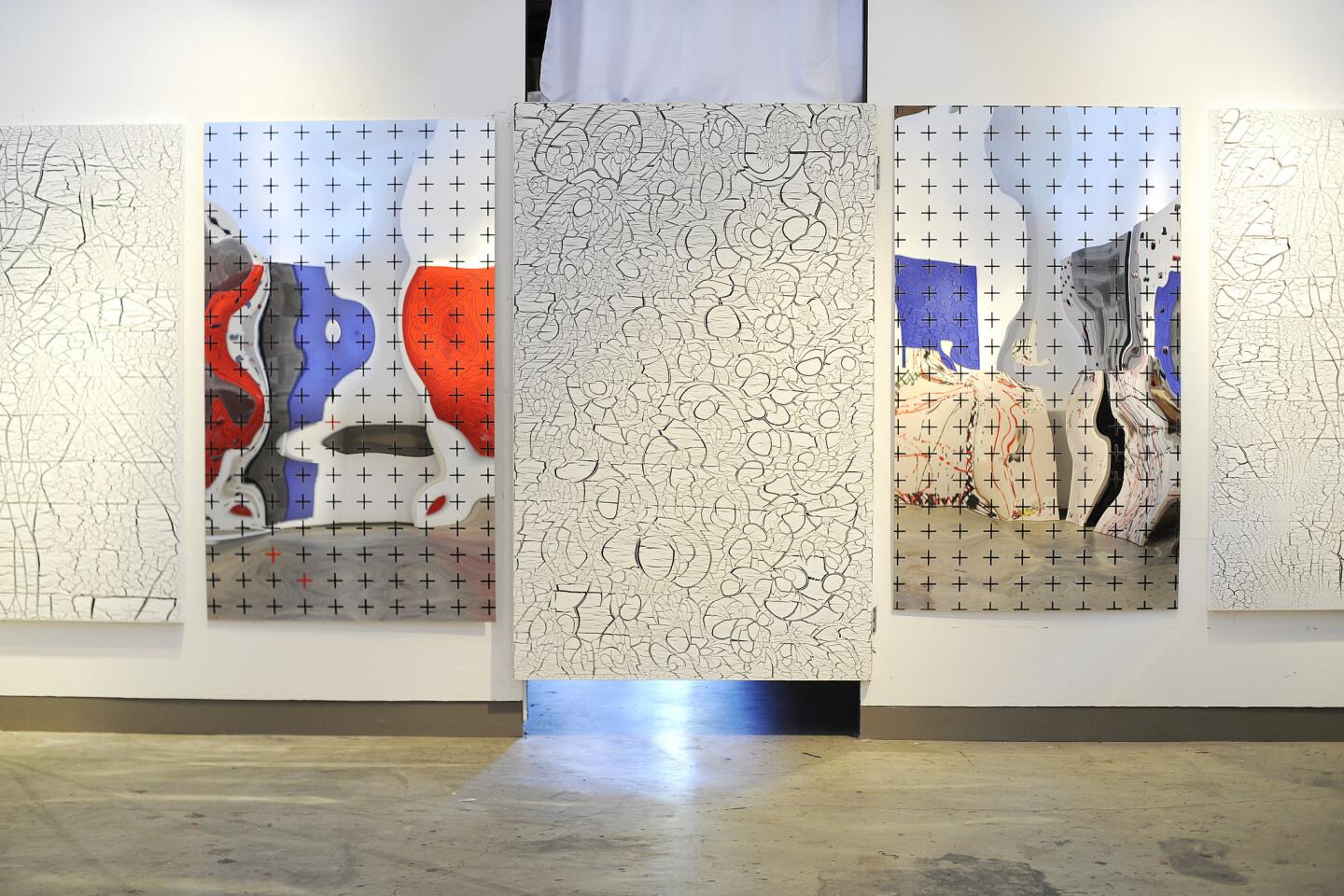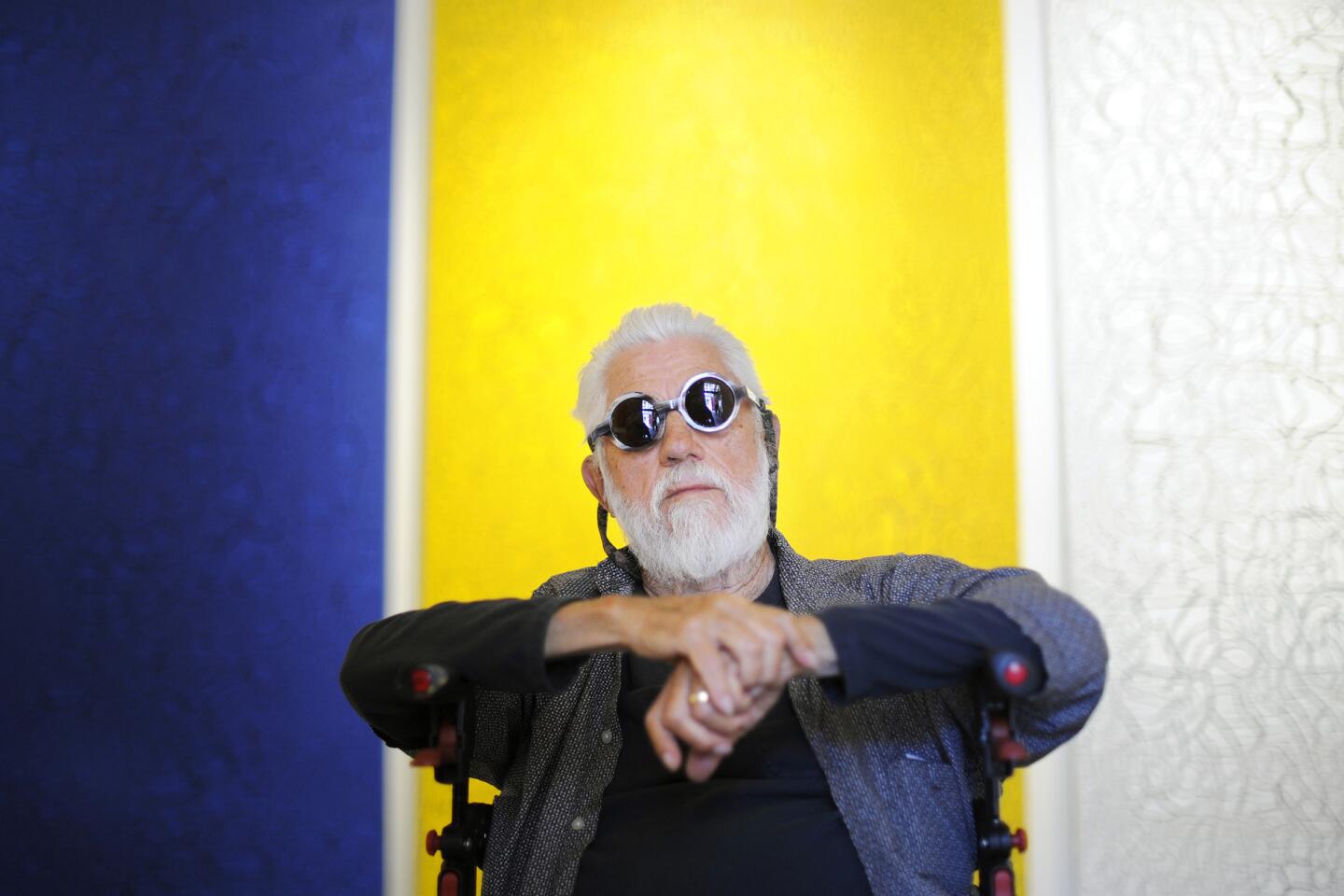At 90, abstract painter and ‘retired playboy’ Ed Moses has new works to show
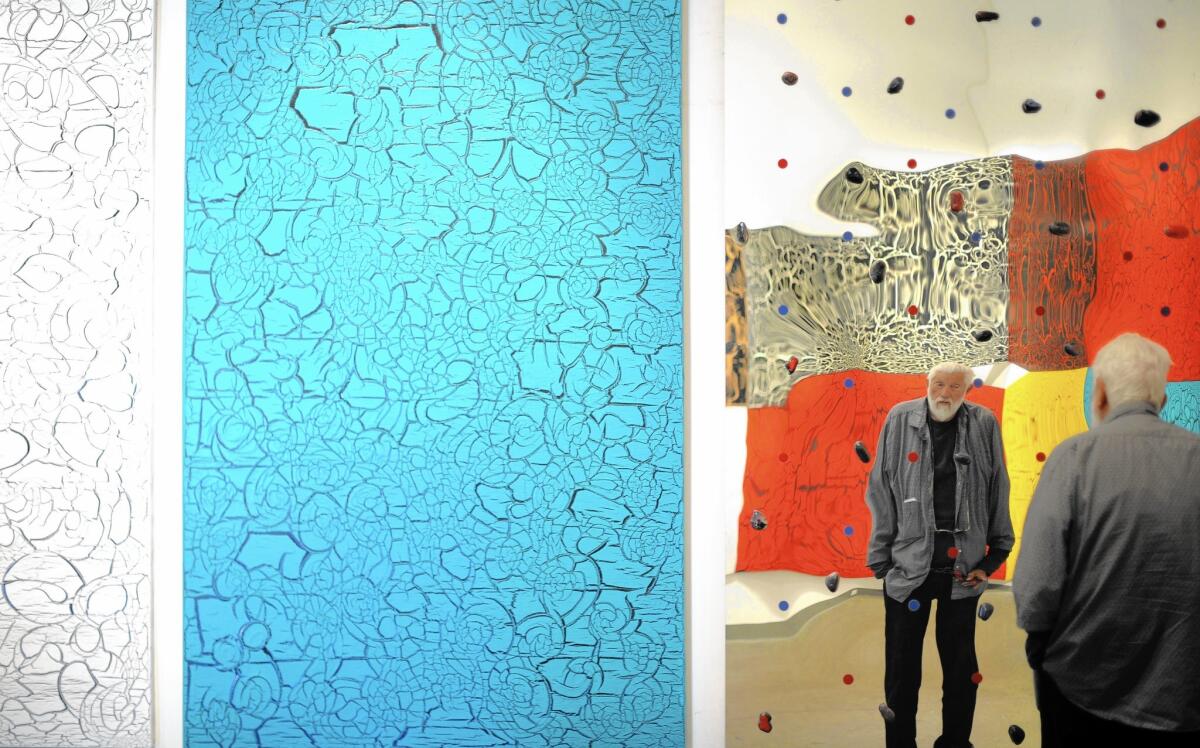
Everything is in motion, not least of all the artist himself.
Through a lushly landscaped Zen garden, beyond a fire pit adorned with Buddha statues and behind a grouping of bungalows on the Venice property where Ed Moses lives, a tempestuous storm unfurls.
About 20 giant paintings-in-progress lie on the concrete, an outdoor clearing Moses calls his studio, which is violently splattered with four decades of paint. The angry wind whips around the canvases, kicking up dust and loose paper. Fake paper flowers sway back and forth. Wind chimes, accentuated by nearby construction clamor, create a hollow symphony of banging and clanking, and a spindly, 20-foot-tall cactus bends with the elements, as if it might snap.
See the most-read stories in Entertainment this hour >>

When Ed Moses turned 90 years old in 2016, William Turner Gallery marked the milestone with a survey of decades of Moses’ work. The artist made more than 50 new paintings for the show, and here he talks about it from his home studio in Venice.
The 90-year-old Moses — in a floppy pink sun hat and paint-stained Birkenstocks — zips over in a paint-spattered transport chair.
“I’m full of ... and vinegar today,” he bellows, using an unprintable expression to describe his feistiness. “You caught me on a good day!”
He jerks the chair to a stop at the edge of the paintings.
“These are all self-portraits,” he says of the vibrantly colored patches, scribbles and paint dribbles studded with Xs and jagged circular forms. “These paintings have history, action — scars and blemishes, scratches and imperfections. These are me.”
Then, soon after: “You have great legs. I checked ‘em out when you were walking away.”
The abstract painter and self-described “retired playboy,” who was part of L.A.’s scene-shaping Ferus Gallery in the ‘50s and ‘60s, is still a flirt, and he’s nothing if not prolific. The L.A. art-world fixture is about to reassert himself as one of the city’s most productive and experimental artists of the last half-century.
Moses is creating more than 50 new works for a survey exhibition debuting at William Turner Gallery on Saturday. Marking his milestone birthday this month, “Moses @ 90” will fill the Bergamot Station gallery and the adjacent former space of the Santa Monica Museum of Art with paintings and works on paper from the ‘50s to the present. Many works in the show have never been seen publicly before.
Moses had a retrospective at L.A.’s Museum of Contemporary Art in 1996, and he’s had recent, more focused shows, such as “Ed Moses: Drawings From the 1960s and ‘70s” at the Los Angeles County Museum of Art last year. But this new show is the artist’s first survey of both paintings and works on paper in 20 years.
“I’m thrilled,” he says of seeing so many decades of work displayed at once. “I guess I didn’t [waste] all the time I thought I did.”
Losing track of time is integral to Moses’ art practice. A Buddhist since 1971, he meditates every day. His art — and life — is about “exploring the phenomenal world,” he says. As many of his contemporaries in the ‘60s and ‘70s were working in conceptual and Pop art, assemblage and Light and Space, Moses didn’t embrace any one movement. Instead, experimentation was his constant. By remaining utterly present when painting — without imposing preconceived concepts onto his canvases — he opens himself up to the “happy accidents” that occur when making art. The work, then, becomes about making art and how materials interact; it’s an ode to the artistic process itself.
“He’s one of the preeminent mark makers in the States,” says Leslie Jones, who curated Moses’ LACMA show. “Ed doesn’t hide his mistakes. It’s actually part of his process. A lot of his work feels unfinished and open-ended. He leaves tape in his work. He wants you to understand how the work came into being. There are no secrets. It’s very honest.”
Moses’ home reflects his philosophy of continual evolution. Over the years, he’s added to the original 1926 shack multiple times, building a second level here, an extra room or storage shed there, then a bathroom and two freestanding art galleries to what’s now an oddly shaped amalgam across two lots.
“They’re mutations. I morph things,” says Moses, who goes by the self-coined nickname “The Mutator.” “They’re pieces stacking up. I add one to the other. Much like I do everything else. It’s about motion, what is.”
Moses was literally born on the go — on an ocean liner from Hawaii to Long Beach, where his mother, newly separated from his father, was relocating. Moses grew up there but spent occasional summers with his father, who worked for a banking company in Hawaii. His eldest brother died before he was born, and his second-eldest brother died of a heart valve issue when Moses was 10.
Moses says he was destined to be an artist. When he was an infant, as the story goes, his aunt found him lying in his bassinet smearing baby poop on the walls. “She said: ‘That kid’s gonna be an artist!’” Moses says.
But Moses wanted to be a doctor. During World War II, he served about two years in the Navy as a surgical technician. He eventually entered the pre-med program at Long Beach City College. “But I couldn’t cut it. I was too dumb, I couldn’t memorize things,” he jokes. An art class there with painter Pedro Miller, taken on a whim, changed his direction, and he later enrolled in the art program at UCLA. While there, the artist Craig Kauffman introduced him to Ferus Gallery owner Walter Hopps. Moses held his UCLA graduate exhibition, a one-man show, at Ferus in 1958.
At Ferus, Moses was part of a raucous group of hard-partying, skirt-chasing artists, he says. Nicknamed the “Cool School,” the Ferus artists — who included Kauffman, Billy Al Bengston, Robert Irwin, Edward Kienholz, John Altoon, Wallace Berman, Ed Ruscha and Larry Bell — helped to shape the nascent West Coast art scene.
“It was just this group of guys who came together that were contradictory to everybody else,” Moses says. “We knew we were particular and that we were the best.”
There was competition among them — for women and notoriety, Moses says — but also fierce collegiality. Many of them remain close today, attending one another’s art openings and personal celebrations. The day after Moses turned 90, his friend Charles Arnoldi turned 70 and held a birthday dinner at his studio. Moses and Bell were there, along with Moses’ other close artist friends, including Peter Alexander, Tony Berlant and Frank Gehry.
“We still hang out in each other’s studios,” Moses says. “We just talk, recount, laugh, tell lies, deride people.”
Moses may have been something of a restless sailor type when he was young, but Avilda Peters, “a beautiful, glamorous girl from Virginia,” anchored him, Moses says. The two met at a Fourth of July kite-flying party on a Malibu beach.
“I was immediately attracted to her,” Moses says, “and at the end of the evening, I said: ‘I’d like to get together with you again.’ She said: ‘That’s not gonna happen. You’re the rudest boy I ever met.’ I thought to get women, you had to be aggressive.”
Moses proposed a week later on a San Diego bluff overlooking the ocean. They had two sons, Cedd, now a nightlife impresario, and Andy, a painter.
Moses and Peters divorced 17 years later but stayed close. Last year they remarried, after 40 years, in Moses’ art studio.
“I just decided I loved her and wanted her to live with me. She’s the love of my life,” Moses says.
Despite cancer (now in remission) and heart valve surgery last year, Moses is robust. He paints every day, creating between one and 20 works a day, he says. He has filled storage units on his property with new work and rents a large El Segundo storage space for the overflow.
The William Turner exhibition will display samplings from each period in Moses’ career. That includes his earliest ‘50s-era architectural Venice drawings and graphite rose drawings from the ‘60s, his grid-like paintings on paper from the ‘70s all the way through to the looser, sponge and snap-line paintings from the mid-2000s. A section of Moses’ newest paintings will also be on view.
Those new works, for now, hang in two lofty barn-like viewing studios on Moses’ property. One studio displays enormous, craquelure paintings created in the last two years. He lays black or white paint onto 6- to 8-feet-tall canvases before adding a “secret sauce” and letting it dry. Then he slams his fist or elbow onto the surface, creating a flurry of splits and cracks, before rolling paint over the surface — a technique he discovered by accident one day when he fell onto a canvas. For such a violent process, the works are oddly soft and feminine, the roiling fissures reminiscent of blooming flower petals and bringing to mind Moses’ ‘60s rose drawings.
“I got the idea from an old Mondrian painting,” Moses says.
Other craquelure panels are made of aluminum-coated plastic so their wavy surface distorts reflections of the ceiling, floor or viewers’ faces, “Lewis Carroll-style,” Moses says.
The other studio houses Moses’ newest work, made in mid-April. The acrylic works on canvas are bursting with energy, an emotional imprint of the moment they were created. From the splatters, paint drizzles and loose patchwork, one can easily imagine Moses hovering over them with brushes and rollers and sponges in an erratic, Jackson Pollock-like manner.
“I’m an action painter,” Moses says. “These paintings are ways that I can act out a thought or feeling — terror, misery, death.”
The rough-edged circles on one painting represent Moses’ own head, laughing or crying, he says. The aluminum surface of another work is studded with painted rocks; it’s positioned on the wall so that it reflects a similar work hanging opposite it, offering a depth of reflections.
“His process, it’s very much like a labyrinth. He dives in, and the painting that evolves is him finding his way out,” William Turner says. “It’s amazing to see someone entering his ‘90s going guns a-blazing with so much passion. It’s truly inspiring. He’s definitely not going quietly into this next stage of his career.”
Moses will have a solo exhibition opening this September at New York’s Albertz Benda Gallery. “Ed Moses: Painting as Process” will include works from the ‘50s to ‘90s that illustrate the unifying factors in Moses’ seemingly disparate bodies of work.
Just don’t ask Moses where his work is headed.
“I never know,” he says, now resting in his garden. The breeze picks up again, rustling through the trees and wild grasses. The sound of slamming wind chimes mounts.
“I’m finding out as I go, I’m an explorer,” Moses says. “I want the work to be in flux, because it is in flux. My life is in flux.”
------------
‘Moses @ 90’
Where: William Turner Gallery, 2525 Michigan Ave., Santa Monica
When: Saturday-June 25. Closed Sundays.
Admission: Free
Info: (310) 453-0909, www.williamturnergallery.com
ALSO
She’ll take the Broad for $1,000: How the art museum became a category on ‘Jeopardy!’
Can Vanna Venturi House and other landmark homes survive the test of new owners?
Turner’s FilmStruck streaming TV service will bring art house movies into homes
How Key and Peele got Keanu Reeves to voice a cat in ‘Keanu’
More to Read
The biggest entertainment stories
Get our big stories about Hollywood, film, television, music, arts, culture and more right in your inbox as soon as they publish.
You may occasionally receive promotional content from the Los Angeles Times.
